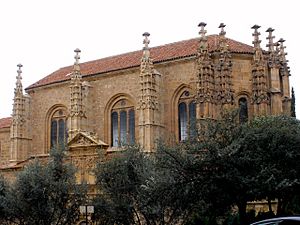Church of Sancti Spiritus facts for kids
The Church of Sancti Spiritus (which means Holy Spirit in Spanish) is a historic church located in the city of Salamanca, Spain. It was officially recognized as an important cultural site in 1888.
Quick facts for kids Church of Sancti Spiritus |
|
|---|---|
| Native name Spanish: Iglesia de Sancti Spiritus |
|
 |
|
| Location | Salamanca, Spain |
| Official name: Iglesia de Sancti Spiritus | |
| Type | Non-movable |
| Criteria | Monument |
| Designated | 1888 |
| Reference no. | RI-51-0000055 |
| Lua error in Module:Location_map at line 420: attempt to index field 'wikibase' (a nil value). | |
Contents
A Look Back in Time
The story of Sancti Spiritus began in 1268. It was founded as a convent by Martín Alfonso de León, who was the son of King Alfonso IX of León, and his wife, María Méndez de Sousa. Just a year later, in 1269, they gave the convent to the Order of Santiago. This was a special group of knights and nuns.
This convent was one of the most important places for the Order of Santiago in the kingdom of León. It served as a hospital, helping people who were sick or in need.
Between 1268 and 1379, four important women helped support the monastery. The first was María Méndez de Sousa, who helped start it. Other powerful women, like Queen María de Molina, also protected the convent. Even though the kings of Castile didn't give land to the monastery, they often confirmed its special rights and helped it when it had problems with the Order of Santiago or the city of Salamanca.
The convent was also a safe place for the wives of knights from Salamanca who went off to war. Because of this, the nuns who lived there became known as "Commanders." Since they were connected to the Order of Santiago, they were called the "Commanders of Santiago."
From Convent to Community Space
In the 1830s, the Spanish government took over many church properties. Because of this, the convent of Sancti Spiritus was changed into a prison. Over the years, it was used for other things too, like housing the local police.
Sadly, in 1965, the convent building was completely torn down. Later, new homes were built on the site. A new street, called Rondín de Santi-Spiritus, was also created next to the chapel of the Santísimo Cristo de los Milagros.
What You Can See Today
The church building itself was repaired and updated in the mid-1500s. It mixes older Gothic styles with newer, fancy Plateresque decorations.
Inside the church, you can see a beautiful choir area. There's also a special chapel with a Mudejar coffered ceiling. This ceiling has amazing patterns from the 1400s and 1500s. You can also find the "Cristo de los Milagros" (Christ of Miracles), a statue from the 1300s. The main altarpiece, which is a large decorated screen behind the altar, was made by Antonio de Paz.
The tombs of Martín Alfonso de León and María Méndez de Sousa are in the front part of the church, but they are very old and not well preserved.
On the outside of the church, the Renaissance-style front is very impressive. It has many sculptures, including images that tell stories from famous works by Petrarch. You can also see round carvings with the faces of Saint Peter and Saint Paul. There's even a scene showing Santiago (Saint James) in the battle of Clavijo. The nuns used to say that Saint James promised victory to the Christians in that battle if the first Christian knight to die gave his belongings to the convent.
Special Burials
Between the 1200s and 1300s, three important people from the royal families of León and Castile were buried in this church:
- Martín Alfonso de León, who was the son of King Alfonso IX of León.
- María Méndez de Sousa, Martín Alfonso's wife.
- Violante Sánchez de Castilla, who was the daughter of King Sancho IV of Castile.
See also
 In Spanish: Iglesia de Sancti Spiritus (Salamanca) para niños
In Spanish: Iglesia de Sancti Spiritus (Salamanca) para niños

